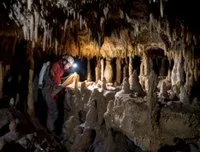 |
| A reconstruction of a Neanderthal man. Credit: Neanderthal Museum. |
Scientists from the University of Bologna believe they have shown that the climate was relatively stable for the three thousand years that Homo sapiens and Homo neanderthalensis coexisted.
This means that climate change alone would not have caused Neanderthals to become extinct, pointing the finger at moderns as the culprit - probably by having better hunting technology.
They reached this conclusion by examining stalagmites in a cave in the Murge karst plateau Apulia, Italy where Moderns and Neanderthals are known to have coexisted between 45,000 and 42,000 years ago.
The team, led by Andrea Columbu of the Department of Biological, Geological and Environmental Sciences, published their findings in Nature Ecology & Evolution a few days ago. Unfortunately the contents are behind a paywall, but the University of Bologna news item has the details:
 |
| Stalagmite in the Pozzo Cucù cave, in the Castellana Grotte area (Bari) |
The researchers focused on the Murge karst plateau in Apulia, where Neanderthals and Homo Sapiens coexisted for at least 3,000 years, from approximately 45,000 to 42,000 years ago. This study was published on Nature Ecology & Evolution. Data extracted from the stalagmites showed that climate changes that happened during that timespan were not particularly significant. "Our study shows that this area of Apulia appears as a 'climate niche' during the transition from Neanderthals to Homo Sapiens" explains Andrea Columbu, researcher and first author of this study. "It doesn't seem possible that significant climate changes happened during that period, at least not impactful enough to cause the extinction of Neanderthals in Apulia and, by the same token, in similar areas of the Mediterranean".
The climate change hypothesis
The hypothesis that a changing climate was a factor in Neanderthals extinction (that happened, in Europe, nearly 42,000 years ago) found considerable support among the scientific community. According to this theory, during the last ice age, sharp and rapid changes in climate were a decisive factor in Neanderthals’ extinction because of the increasingly cold and dry weather.
We can find confirmation of these sharp changes in the analysis of ice cores from Greenland and from other paleoclimatic archives of continental Europe. However, when it comes to some Mediterranean areas where Neanderthals had lived since 100,000 years ago, the data tell a different story. The Western Mediterranean is rich in prehistorical findings and, until now, no one ever carried out a paleoclimatic reconstruction of these Neanderthals-occupied areas.
The importance of stalagmites
Where to find answers about the climate past of the Western Mediterranean? The research group of the University of Bologna turned to the Murge plateau in Apulia. "Apulia is key to our understanding of anthropological movements: we know that both Neanderthals and Homo Sapiens lived there approximately 45,000 years ago", says Andrea Columbu. "Very few other areas in the world saw both species co-existing in a relatively small space. This makes the Murge plateau the perfect place to study the climate and the bio-cultural grounds of the transition from Neanderthal to Sapiens".
How is it possible to provide a climate reconstruction of such a remote period? Stalagmites have the answer. These rock formations rise from the floor of karst caves thanks to ceiling water drippings. "Stalagmites are excellent paleoclimatic and paleoenvironmental archives", explains Jo De Waele, research coordinator and professor at the University of Bologna. "Since stalagmites form through rainwater dripping, they provide unquestionable evidence of the presence or absence of rain. Moreover, they are made of calcite, which contains carbon and oxygen isotopes. The latter provide precise information about how the soil was and how much it rained during the formation period of stalagmites. We can then cross these pieces of information with radiometric dating, that provide an extremely precise reconstruction of the phases of stalagmites’ formation".
A (relatively) stable climate
The pace at which stalagmites formed is the first significant result of this study. Researchers found out that Apulian stalagmites showed a consistent pace of dripping in the last and previous ice ages. This means that no abrupt change in climate happened during the millennia under investigation. A draught would have been visible in the stalagmites.
Among all the stalagmites that were analysed, one was particularly relevant. Researchers sampled this 50-cm long stalagmite in the Pozzo Cucù cave, in the Castellana Grotte area (Bari) and they carried out 27 high-precision datings and 2,700 analyses of carbon and oxygen stable isotopes. According to the dating, this stalagmite formed between 106,000 and 27,000 years ago. This stalagmite represents the longest timeline of the last ice age in the western Mediterranean and in Europe. Moreover, this stalagmite did not show any trace of abrupt changes in climate that might have caused Neanderthals' extinction.
"The analyses we carried out show little variation in rainfall between 50,000 and 27,000 years ago, the extent of this variation is not enough to cause alterations in the flora inhabiting the environment above the cave", says Jo De Waele. "Carbon isotopes show that the bio-productivity of the soil remained all in all consistent during this period that includes the 3,000 years-long coexistence between Sapiens and Neanderthals. This means that significant changes in flora and thus in climate did not happen".
So, if climate change was not a significant factor over the period in question, the question become what exactly did cause Neanderthals to go extinct. The only other major environmental change was the presence of modern humans. The finding is consistent with the views of anthropologists that it was the superior hunting technology of moderns which meant they out-competed Neanderthals for food resources.

No comments:
Post a Comment
Obscene, threatening or obnoxious messages, preaching, abuse and spam will be removed, as will anything by known Internet trolls and stalkers, by known sock-puppet accounts and anything not connected with the post,
A claim made without evidence can be dismissed without evidence. Remember: your opinion is not an established fact unless corroborated.